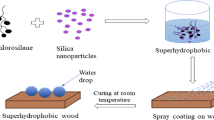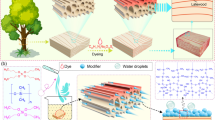Abstract
Wood is still a widely used raw material in many fields and is surface-modified for diverse applications. Though a few studies reported the anti-fungal effect derived from enhanced hydrophobicity of wood surface, no report about the influence of superhydrophobic surface upon fungi is known and the comparison of anti-fungal effects between hydrophobicity and superhydrophobicity on wood surface has not been demonstrated. We herein addressed these aspects regarding the anti-fungal properties of both hydrophobic and superhydrophobic wood. Hydrophobic and superhydrophobic beech and pine, representing hard- and softwood were fabricated, using environmentally friendly organic materials (cellulose and glycerol). Cellulose stearoyl ester was used for dip-coating (1st layer) the wood, leading to a hydrophobic surface and glycerol stearoyl ester was used for brush-coating (2nd layer) the wood, leading to a hierarchical superhydrophobic surface. Results showed that hydrophobic and superhydrophobic woods exhibited better anti-fungal properties comparing with non-treated wood. Furthermore, differential anti-fungal effects of hydrophobic and superhydrophobic wood were observed: superhydrophobic wood could thoroughly prevent fungal attachment to treated wood, while fungi could still be found inside hydrophobic wood after anti-fungal test.






Similar content being viewed by others
References
Bravery A (1988) Biodeterioration of paint—a state-of-the-art comment. In: Houghton DR, Smith RN, Eggins HOW (eds) Biodeterioration, vol 7. Springer, Dordrecht, pp 466–485
Carey JK (1980) The mechanism of infection and decay of window joinery. University of London, London
Chang H et al (2015) Fabrication of mechanically durable superhydrophobic wood surfaces using polydimethylsiloxane and silica nanoparticles. RSC Adv 5(39):30647–30653
Chen Y et al (2007) Role of peptide hydrophobicity in the mechanism of action of α-helical antimicrobial peptides. Antimicrob Agents Chemother 51(4):1398–1406
Gao L et al (2015) A robust, anti-acid, and high-temperature–humidity-resistant superhydrophobic surface of wood based on a modified TiO2 film by fluoroalkyl silane. Surf Coat Technol 262:33–39
Geissler A et al (2014a) Temperature-responsive thin films from cellulose stearoyl triester. J Phys Chem C 118(5):2408–2417
Geissler A et al (2014b) Thermo-responsive superhydrophobic paper using nanostructured cellulose stearoyl ester. Cellulose 21(1):357–366
Guillemot G et al (2008) Plasma deposition of silver nanoparticles onto stainless steel for the prevention of fungal biofilms: a case study on Saccharomyces cerevisiae. Plasma Process Polym 5(3):228–238
Hakkou M et al (2005) Investigation of wood wettability changes during heat treatment on the basis of chemical analysis. Polym Degrad Stab 89(1):1–5
Kuroda K et al (2009) The role of hydrophobicity in the antimicrobial and hemolytic activities of polymethacrylate derivatives. Chem Eur J 15(5):1123–1133
Lesar B et al (2011) Wax treatment of wood slows photodegradation. Polym Degrad Stab 96(7):1271–1278
Liu C et al (2011) Fabrication of superhydrophobic wood surfaces via a solution-immersion process. Appl Surf Sci 258(2):761–765
Liu M et al (2015) Facile fabrication of superhydrophobic surfaces on wood substrates via a one-step hydrothermal process. Appl Surf Sci 330:332–338
Raghavan SR et al (1998) Composite polymer electrolytes based on poly (ethylene glycol) and hydrophobic fumed silica: dynamic rheology and microstructure. Chem Mater 10(1):244–251
Rowell RM et al (2009) Understanding decay resistance, dimensional stability and strength changes in heat-treated and acetylated wood. Wood Mat Sci Eng 4(1–2):14–22
Vaca-Garcia C et al (2001) Determination of the degree of substitution (DS) of mixed cellulose esters by elemental analysis. Cellulose 8(3):225–231
Van de Velde K, Kiekens P (2004) Structure analysis and degree of substitution of chitin, chitosan and dibutyrylchitin by FT-IR spectroscopy and solid state 13C NMR. Carbohyd Polym 58(4):409–416
Wang S, Jiang L (2007) Definition of superhydrophobic states. Adv Mater 19(21):3423–3424
Wang C et al (2011a) Synthesis and characterization of superhydrophobic wood surfaces. J Appl Polym Sci 119(3):1667–1672
Wang S et al (2011b) Fabrication of a superhydrophobic surface on a wood substrate. Appl Surf Sci 257(22):9362–9365
Wen L et al (2015) Bioinspired super-wettability from fundamental research to practical applications. Angew Chem Int Ed 54(11):3387–3399
Xie Y et al (2008) Weathering of uncoated and coated wood treated with methylated 1, 3-dimethylol-4, 5-dihydroxyethyleneurea (mDMDHEU). Eur J Wood Wood Prod 66(6):455–464
Yin LM et al (2012) Roles of hydrophobicity and charge distribution of cationic antimicrobial peptides in peptide-membrane interactions. J Biol Chem 287(10):7738–7745
Zabel RA, Morrell JJ (2012) Wood microbiology: decay and its prevention. Academic Press, San Diego
Zabel R, Terracina F (1978) Nutrition of saprobic fungi and control strategies for paint mildew caused by< i> Aureobasidium pullulans. J Coat Technol 50(639):43–47
Zabel R, Terracina F (1980) The role of Aureobasidium pullulans in the disfigurement of latex paint films. Dev Ind Microbiol 21:179–190
Zhang K et al (2015) Polymeric flower-like microparticles from self-assembled cellulose stearoyl esters. ACS Macro Lett 4(2):214–219
Acknowledgments
Y.Y. thanks the China Scholarship Council (CSC) for financial support. K.Z. thanks Georg-August-University of Goettingen for the Anschubfinanzierung (Funding for the promotion of Young Academics of University of Goettingen) and Fonds der Chemischen Industrie (FCI) for the financial support. Y.Y. thanks Petra Heinze for the help of anti-fungal test; Katharina Dabow and Martin Kaßel for the instruction of Contact Angle Meter.
Author information
Authors and Affiliations
Corresponding author
Electronic supplementary material
Below is the link to the electronic supplementary material.
Superhydrophobic beech (MP4 11114 kb)
Superhydrophobic pine (MP4 6975 kb)
Rights and permissions
About this article
Cite this article
Yao, Y., Gellerich, A., Zauner, M. et al. Differential anti-fungal effects from hydrophobic and superhydrophobic wood based on cellulose and glycerol stearoyl esters. Cellulose 25, 1329–1338 (2018). https://doi.org/10.1007/s10570-017-1626-x
Received:
Accepted:
Published:
Issue Date:
DOI: https://doi.org/10.1007/s10570-017-1626-x




